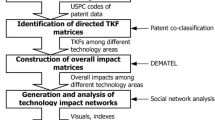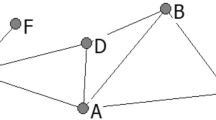Abstract
This study explores boundary-crossing networks in fuel-cell science and technology. We use the case of Norwegian fuel cell and related hydrogen research to explore techno-science networks. Standard bibliometric and patent indicators are presented. Then we explore different types of network maps — maps based on co-authorship, co-patenting and co-activity data. Different network configurations occur for each type of map. Actors reach different levels of prominence in the different maps, but most of them are active both in science and technology. This illustrates that to appreciate fully the range of science-technology interplay, all three analyses need to be taken into account.
Similar content being viewed by others
References
Avadikyan, A., Cohendet, P., Heraud, J.-A. (2003), The Economic Dynamics of Fuel Cell Technologies. Berlin Heidelberg: Springer Verlag.
Balconi, M., Laboranti, A. (2006), The role of academic centres of excellence in connecting university and industry: the case of microelectronics in Italy. Forthcoming in Research Policy.
Bassecoulard, E., Zitt, M. (2004), Patents and publications: The lexical connection. In: Moed et al. (2004) pp. 665–694.
Bhattacharya, S., Meyer, M. (2003), Large firms and the science/technology interface — patents, patent citations, and scientific output in thin films. Scientometrics, 58(2): 265–279.
Bhattacharya, S., Kretschmer, H., Meyer, M. (2003), Characterizing intellectual spaces between science and technology. Scientometrics, 58(2): 369–390.
Coward, H. R., Franklin, J. J. (1989), Identifying the science-technology interface — matching patent data to a bibliometric model. Science, Technology & Human Values, 14(1): 50–77.
Engelsman, E. C., Van Raan, A. F. J. (1994), A patent-based cartography of technology. Research Policy, 23(1): 1–26.
Etzkowitz, H. (1983), Entrepreneurial scientists and entrepreneurial universities in American academic science. Minerva, 21(2–3): 198–233.
Etzkowitz, H., Leydesdorff, L. (1997), Universities and the Global Knowledge Economy: A Triple Helix of University-Industry-Government Relations. Pinter.
Gittelman, M., Kogut, B. (2003), Does good science lead to valuable knowledge? Biotechnology firms and the evolutionary logic of citation patterns, Management Science, 49(4): 366–382.
Glänzel, W., Schlemmer, B., Schubert, A., Thijs, B. (2005), Proceeding literature as additional data source for bibliometric analysis. Paper presented at the ISSI 2005 — 10th International Conference of the ISSI, Stockholm.
Glenisson, P., Glänzel, W., Persson, O. (2005), Combining full-text analysis and bibliometric indicators: a pilot study. Scientometrics, 63(1): 163–180.
Godø, H., Nerdrum, L., Rapmund, A., Nygaard, S. (2003), Innovation in Fuel Cells and Related Hydrogen Technology in Norway—OECD Case Study in the Energy Sector. NIFU, Oslo.
Godoe, H., Nygaard, S. (2005), System failure, innovation policy and patents: Fuel cells and related hydrogen technology in Norway 1990–2002. Energy Policy, In Press.
Hall, J., Kerr, R. (2003), Innovation dynamics and environmental technologies: the emergence of fuel cell technology. Journal of Cleaner Production, 11: 459–471.
Hassan, E. (2003), Mapping the knowledge base for fuel cells: A bibliometric approach. Paper presented at the International Conference on Innovation in Energy Technologies, Washington, 2003. http://www.oecd.org/dataoecd/3/17/15937671.pdf
Hassan, E. (2005), The evolution of the knowledge structure of fuel cells. Scientometrics, 62: 223–238.
Hullmann, A., Meyer, M. (2003), Publications and patents in nanotechnology. An overview of previous studies and the state of the art. Scientometrics, 58(3): 507–527.
Kaloudis, A., Koch, P. M. (2004). De nœringsrettede instituttenes rolle i det fremtidige innovasjonssystemet. Oslo: NIFU STEP.
Katz, J. S., Martin, B. R. (1997), What is research collaboration? Research Policy. 26: 1–18.
Leydesdorff, L. (2003), The mutual information of university-industry-government relations: An indicator of the Triple Helix dynamics. Scientometrics, 58(2): 445–467.
Leydesdorff, L. (2004), The university-industry knowledge relationship: Analyzing patents and the science base of technologies. JASIST, 55(11): 991–1001.
Leydesdorff, L., Meyer, M. (2003), The triple helix of university-industry-government relations: A model for innovation in the ‘knowledge-based’ economy. Introduction to the Triple Helix special issue. Scientometrics, 58 (2): 191–203.
Luukkonen, T., Persson, O., Sivertsen, G. (1992). Understanding patterns of international scientific collaboration. Science, Technology & Human Values, 17: 101–126.
Mahlck, P., Persson, O. (2000), Socio-bibliometric mapping of intra-departmental networks. Scientometrics, 49(1): 81–91.
Melin, G. (1996), The networking university. Scientometrics, 35: 15–31.
Melin, G., Persson, O. (1998), Hotel cosmopolitan: A bibliometric study of collaboration at some European universities. JASIST, 49(1): 43–48.
Melin, G., Persson, O. (1996), Studying research collaboration using co-authorships. Scientometrics, 36(3): 363–377.
Melin, G., Danell, R., Persson, O. (2000), A bibliometric mapping of the scientific landscape on Taiwan. Issues and Studies, 36(5): 61–82.
Meyer, M. (2005), Inventor-Authors: Knowledge Integrators or Weak Links? An Exploratory Comparison of Co-active Researchers with Their Non-inventing Peers in Nano-science and Technology (Report Number 2005/1). Helsinki University of Technology, Espoo.
Meyer, M., Bhattacharya, S. (2004), Commonalities and differences between scholarly and technical collaboration: an exploration of co-invention and co-authorship analyses. Scientometrics, 61(3): 443–456.
Meyer, M., Persson, O., Power, Y.; with Nanotechnology Expert Group and Eurotech Data (2002), Mapping Excellence in Nanotechnologies. Preparatory study for the European Commission, DG Research.
Meyer, M., Siniläinen, T., Utecht, J. T. (2003), Towards hybrid Triple Helix indicators — A study of university-related patents and a survey of inventors. Scientometrics, 58(2): 321–350.
Meyer, M. S. (2001), Patent citation analysis in a novel field of technology: An exploration of nano-science and nano-technology. Scientometrics, 51(1): 163–183.
Moed, H. F., Glänzel, W., Schmoch, U. (Eds) (2004), Handbook of Quantitative Science and Technology Research: The Use of Publication and Patent Statistics in Studies of S&T Systems. Kluwer Academic Publishers: Dordrecht.
Murray, F. (2002), Innovation as co-evolution of scientific and technological networks: Exploring tissue engineering. Research Policy, 31(8–9): 1389–1403.
Murray, F., Stern, S. (2004), Do Formal Intellectual Property Rights Hinder the Free Flow of Scientific Knowledge? An Empirical Test of the Anti-Commons Hypothesis. SPRU Conference in Honor of Keith Pavitt, Brighton.
Mytelka, L. (2003), New Wave Technologies: Their Emergence, Diffusion and Impact. The Case of Hydrogen Fuel Cell Technology and the Developing World. Discussion Papers 3, United Nations University, Institute for New Technologies.
Norges forskningsråd (2004), Årsrapport 2003. Forskningsinstituttene: Delrapport for de teknisk-industrielle institutter. Oslo: Norges forskningsråd.
Noyons, E. C. M. (1999), Bibliometric Mapping as a Science Policy and Research Management Tool. Leiden University, Leiden.
Noyons, E. C. M., Buter, R. K., Van Raan, A. F. J., Schmoch, U., Heinze, T., Hinze, S., Rangnow, R. (2004), Mapping Excellence in Science and Technology across Europe: Nanoscience and Nanotechnology. Centre for Science and Technology Studies (CWTS), Leiden University, The Netherlands.
Noyons, E. C. M., Van Raan, A. F. J., Grupp, H., Schmoch, U. (1994), Exploring the science and technology interface — inventor author relations in laser medicine research, Research Policy, 23(4): 443–457.
Nygaard, S. (2003), Innovation in Fuel Cells and Related Hydrogen Technology in Norway: Patents and Knowledge Interaction in a System of Innovation, TIK, University of Oslo, Oslo.
Persson, O. (2001), All author citations versus first author citations. Scientometrics, 50(2): 339–344.
Pilkington, A. (2004a), Inventive concentration in the production of green technology: A comparative analysis of fuel cell patents. Science and Public Policy, 31: 15–25.
Pilkington, A. (2004b), Technology portfolio alignment commercialisation: An investigation of fuel cell patenting. Technovation, 24: 761–771.
Rabeharisoa, V. (1992), A special mediation between science and technology: When inventors publish scientific articles in fuel cells research. In: Grupp, H. (Ed.), Dynamics of Science-Based Innovation, Springer Publishers, Berlin, pp. 45–72.
Schmoch, U. (1997), Indicators and the relations between science and technology. Scientometrics, 38(1): 103–116.
Schmoch, U. (2004), The technological output of scientific institutions. In: Moed et al. (2004), pp. 717–731.
Schummer, J. (2004), Multidisciplinarity, interdisciplinarity, and patterns of research collaboration in nanoscience and nanotechnology. Scientometrics, 59: 425–465.
Tijssen, R. J. W. (2004), Science-technology connections and interactions. In: Moed et al. (2004), pp. 695–715.
Tijssen, R. J. W., Korevaar, J. C. (1997), Unravelling the cognitive and interorganisational structure of public/private R&D networks: A case study of catalysis research in the Netherlands. Research Policy, 25(8): 1277–1293.
Author information
Authors and Affiliations
Corresponding author
Rights and permissions
About this article
Cite this article
Klitkou, A., Nygaard, S. & Meyer, M. Tracking techno-science networks: A case study of fuel cells and related hydrogen technology R&D in Norway. Scientometrics 70, 491–518 (2007). https://doi.org/10.1007/s11192-007-0213-6
Received:
Issue Date:
DOI: https://doi.org/10.1007/s11192-007-0213-6




